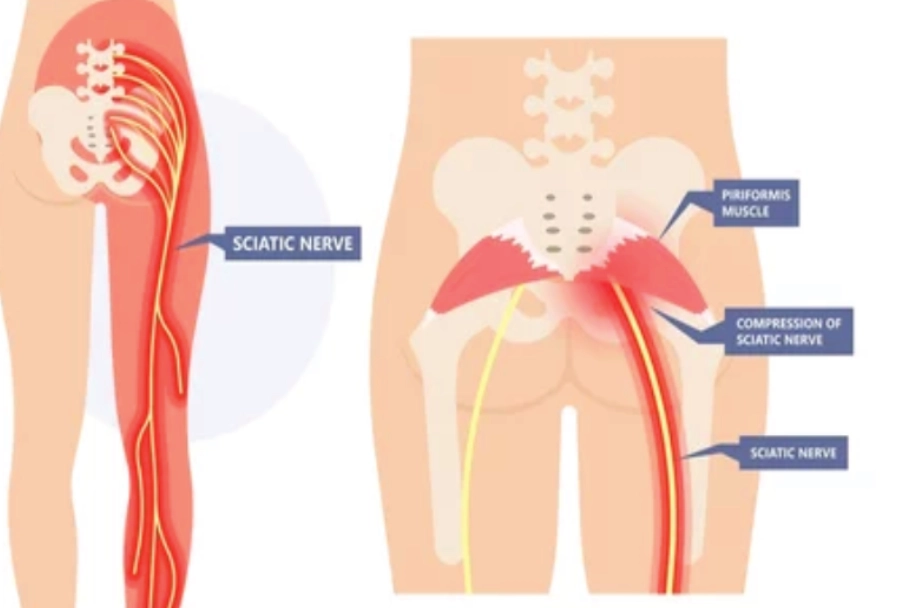Best Physiotherapy for Sciatica Pain You Can Trust
Trust “Best Physiotherapy for Sciatica Pain” for tailored rehabilitation, integrating evidence-based techniques to maximize recovery and restore independence. Our compassionate care and dedicated support aim to guide to our patients towards pain-free life, improved mobility and quality of life.
Best for Sciatica Pain physiotherapy Doctors in Delhi, India

Physiotherapy for Sciatica Pain
Sciatica Pain Physiotherapy in Delhi
Physiotherapy plays a vital role in the management of sciatica by addressing underlying causes, reducing pain, and improving function through a tailored rehabilitation program. By incorporating pain management techniques, therapeutic exercises, and patient education, physiotherapists help individuals recover from sciatica and regain optimal musculoskeletal health.
What is Sciatica Pain
Sciatica is characterized by pain that radiates along the sciatic nerve pathway, originating from the lower back, extending through the hips and buttocks, and down each leg. It typically results from compression or irritation of the sciatic nerve, leading to a spectrum of symptoms ranging from mild discomfort to debilitating pain and numbness. Effective management of sciatica often involves a comprehensive approach that includes physiotherapy to address underlying causes, alleviate pain, and restore functionality.
What Causes Sciatica Pain
Sciatica can stem from various factors:
HERNIATED DISC:
Compression of sciatic nerve roots due to herniation of discs in the lumbar spine.
SPINAL STENOSIS:
Narrowing of the spinal canal or intervertebral foramina, compressing the sciatic nerve.
DEGENERATIVE DISC DISEASE:
Wear and tear of spinal discs causing irritation of the sciatic nerve.
PIRIFORMIS SYNDROME:
Compression of the sciatic nerve by the piriformis muscle in the buttock region.
SPONDYLOLISTHESIS:
Displacement of vertebrae resulting in nerve root compression, including the sciatic nerve.
TRAUMA OR INJURY:
Accidents or injuries affecting the spine leading to sciatica.
SPINAL TUMORS:
Rarely, tumors or growths in the spine can compress the sciatic nerve.
SYMPTOMS:
Common symptoms of sciatica include:
Sharp or shooting pain that radiates from the lower back through the buttocks and down the leg.
Numbness or tingling sensation in the leg or foot.
Weakness in the affected leg muscles.
Difficulty walking or standing for prolonged periods.
Aggravation of pain with movements such as sitting, coughing, or sneezing.
Physiotherapy Treatment for Sciatica Pain
Physiotherapy for sciatica pain involves exercises to alleviate pressure on the sciatic nerve, manual therapy techniques, modalities for pain relief, and education on proper posture and body mechanics.
Physiotherapy & Rehabilitation Sciatica Pain
Physiotherapy plays a crucial role in managing sciatica and typically involves:
ASSESSMENT AND DIAGNOSIS:
Thorough evaluation of symptoms, medical history, and functional limitations to determine the underlying cause.
PAIN MANAGEMENT:
Utilization of modalities such as heat therapy, ice therapy, or electrical stimulation to alleviate pain and reduce inflammation. Manual therapy techniques, including soft tissue manipulation and joint mobilization, can help relieve muscle tension and decompress the spine.
STRETCHING AND FLEXIBILITY EXERCISES:
Specific stretching exercises targeting the muscles of the lower back, hips, and legs can alleviate nerve compression and improve flexibility. Techniques such as hamstring stretches, piriformis stretches, and lumbar spine stretches are often incorporated.
STRENGTHENING EXERCISES:
Strengthening the core muscles, including the abdominal, back, and hip muscles, can stabilize the spine and reduce strain on the sciatic nerve. Exercises such as bridges, pelvic tilts, and bird-dog exercises are commonly prescribed.
POSTURAL CORRECTION AND ERGONOMIC ADVICE:
Education on maintaining proper posture during daily activities and ergonomic adjustments, such as using lumbar support cushions or adjusting workstation setup, helps prevent symptom exacerbation.
FUNCTIONAL REHABILITATION:
Introduction of functional exercises and activities to improve the patient's ability to perform daily tasks without pain. Gradual progression of activities, such as walking, squatting, and lifting, helps restore mobility and function while minimizing the risk of recurrence.
ACTIVITY MODIFICATION:
Modification of activities that exacerbate symptoms, such as prolonged sitting or heavy lifting, is recommended to prevent aggravation of the condition.
FAQs About Sciatica Pain
What are the common causes of sciatica pain?
Sciatica pain is often caused by conditions that compress or irritate the sciatic nerve, such as a herniated disc, spinal stenosis, degenerative disc disease, or muscle spasms in the buttocks.
What are the typical symptoms of sciatica pain?
Common symptoms include pain that radiates from the lower back through the buttocks and down one leg, numbness or tingling sensation in the leg or foot, weakness in the affected leg, and difficulty moving or controlling the leg.
How is sciatica pain diagnosed?
Diagnosis usually involves a physical examination, where the doctor assesses the patient's symptoms and performs certain maneuvers to determine the source of the pain. Imaging tests such as X-rays, MRI, or CT scans may also be ordered to visualize the spine and identify any underlying conditions.
What are the treatment options for sciatica pain?
Treatment often includes a combination of rest, pain medications (such as NSAIDs), physical therapy exercises to improve flexibility and strengthen the muscles supporting the spine, hot or cold therapy, and corticosteroid injections to reduce inflammation around the affected nerve. In severe cases, surgery may be recommended to alleviate pressure on the sciatic nerve.
How long does sciatica pain typically last?
The duration of sciatica pain can vary widely depending on the underlying cause and individual factors. In many cases, symptoms improve within a few weeks with conservative treatments. However, some people may experience chronic or recurring sciatica pain that requires ongoing management and occasionally more aggressive interventions.
Our Treatment Process
Committed To Keep People Healthy & Safe
Our treatment process begins with a thorough assessment, followed by the creation of a personalized plan tailored to your needs. Through active rehabilitation, incorporating various evidence-based techniques, we work to promote healing and improve function. Continuous support and guidance are provided to ensure long-term success.
We start by having a thorough conversation with you about your medical history and any issues you’re experiencing. This helps us understand your unique situation.
We use state-of-the-art software and technology to analyze how your body moves and functions. This gives us a detailed picture of what might be causing your discomfort.
Based on what we find during the assessment, we create a personalized plan just for you. Our goal is to help you achieve specific outcomes, whether it’s reducing pain, improving mobility, or something else.
During your sessions with us, we use a combination of advanced technology and hands-on techniques to address your needs. This might include using special equipment or providing manual therapy to target problem areas.
We keep a close eye on how you’re doing throughout your treatment. By regularly checking your progress, we can make sure you’re on the right track and make any necessary adjustments to your plan.
Once you’ve made significant progress and reached your goals, we’ll guide you through a final session. Here, we’ll provide you with a customized digital exercise program that you can continue at home.
Even after your sessions with us are complete, we’re still here to support you. We offer virtual and online follow-up appointments to check in, answer any questions you may have, and provide ongoing guidance as needed.
At Best Physiotherapy Centre in Delhi We Follow Best Practices
Why Choose Us
We offer personalized care, crafting customized treatment plans based on your unique needs and goals. With expertise in physiotherapy and a holistic approach to healing, our team ensures comprehensive care that addresses both physical and emotional aspects of recovery.
- Personalized Care
- Experienced Professionals
- Expertise & Best Practices
- Holistic Approach
- Latest Technology
State-of-the-Art Facilities
Our facilities are equipped with the latest technology and amenities to create a conducive environment for rehabilitation and healing. From spacious therapy gyms to private treatment rooms, we prioritize comfort, safety, and accessibility for our patients.
EXPERTISE
Led by Dr. Dharam Pandey, our team comprises highly skilled professionals with extensive experience in stroke rehabilitation.
PERSONALIZED CARE
We believe in a patient-centered approach, tailoring treatment plans to address the individual needs and goals of each patient.
ADVANCED TECHNOLOGY
We harness the power of advanced technology to deliver innovative rehabilitation solutions and optimize outcomes.
COMPASSIONATE SUPPORT
We provide compassionate, supportive care every step of the way, empowering patients to achieve their full potential.
Best Physiotherapy Clinic In Delhi
At Dr. Dharam Pandey and Team, we are committed to redefining the standard of care in neurological rehabilitation. With our expertise, state-of-the-art technology, and unwavering dedication to patient-centric care, we strive to inspire hope, restore function, and improve quality of life for head injury survivors. If you or a loved one is seeking specialized rehabilitation services, we invite you to experience the difference at Dr. Dharam Pandey and Team.
Call Today
+91-9818911195 +91-9818910029









